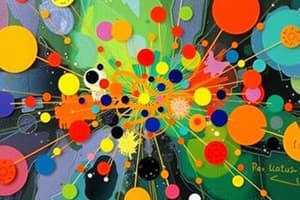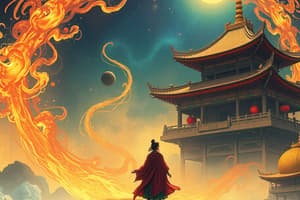Podcast
Questions and Answers
Match the following terms with their definitions:
Match the following terms with their definitions:
Centrifugal forces = Forces that pull people apart within a culture Assimilation = The process of adopting the culture of another group Cultural relativism = Understanding a culture on its own terms Multiculturalism = Acknowledgment of multiple cultural perspectives
Match the following types of diffusion with their descriptions:
Match the following types of diffusion with their descriptions:
Contagious diffusion = Spread of culture through direct contact Stimulus diffusion = Adaptation of a cultural trait from one group to another Relocation diffusion = Movement of individuals who carry their culture to new locations Hierarchical diffusion = Spread of culture through a hierarchy or key person
Match the following cultural concepts with their examples:
Match the following cultural concepts with their examples:
Material culture = Physical objects and artifacts of a culture Folk culture = Traditional practices passed down through generations Popular culture = Trends embraced by a wide audience at a given time Ethnocentrism = Judging another culture by the standards of one's own
Match the following terms with their related concepts:
Match the following terms with their related concepts:
Match the following forces with their effects on culture:
Match the following forces with their effects on culture:
Match the following types of culture with their characteristics:
Match the following types of culture with their characteristics:
Match the following diffusion terms with their meanings:
Match the following diffusion terms with their meanings:
Match the following sociocultural concepts with their implications:
Match the following sociocultural concepts with their implications:
Match the following cultural phenomena with their effects:
Match the following cultural phenomena with their effects:
Flashcards are hidden until you start studying
Study Notes
Cultural Concepts
- Culture encompasses shared values, beliefs, behaviors, and material objects.
- Folk culture is traditionally practiced by small, homogenous groups in rural areas, with strong ties to the land.
- Popular culture is widely diffused and practiced by large, heterogeneous societies, often influenced by mass media.
- Material culture refers to the physical objects created by a culture, such as clothing, tools, and buildings.
- Non-material culture refers to intangible aspects of culture, including values, beliefs, behaviors, and traditions.
- Cultural landscape is the visible imprint of human activity on the landscape, reflecting cultural values and practices.
- Cultural appropriation: adoption of elements of another culture by members of a dominant culture, often without understanding or respect for their significance.
Cultural Processes and Diffusion
- Diffusion is the spread of cultural elements from one place to another.
- Relocation diffusion involves the movement of people who carry their cultural traits with them.
- Contagious diffusion spreads rapidly and widely from person to person, similar to the spread of a disease.
- Hierarchical diffusion involves the spread of cultural elements from powerful centers to other places.
- Stimulus diffusion occurs when an idea or innovation stimulates the creation of a similar but new innovation in another place.
Cultural Interactions
- Acculturation is the process of adapting to the cultural traits of another group, often through contact.
- Assimilation is the process of adopting the cultural traits of another group to such a degree that one’s own cultural identity is lost.
- Syncretism is the blending of cultural elements to form a new, unique cultural trait.
- Multiculturalism is the existence of multiple cultures within a society, often with the goal of respecting and celebrating diversity.
- Ethnocentrism is the belief that one’s own culture is superior to others.
- Cultural relativism is the belief that all cultures are equally valid and should be respected on their own terms.
Forces Shaping Culture
- Centripetal forces unify a society, like shared language, religion, or a common history.
- Centrifugal forces divide a society, like ethnic differences, economic disparities, or political conflicts.
- Commodification is the process of turning something non-material, like a cultural tradition, into a commodity that can be bought and sold.
Cultural Identity and Landscape
-
Local culture: A distinctive and unique cultural group that may stand in contrast to popular culture.
-
Ethnic neighborhoods are areas where people of a shared ethnicity reside and often maintain their traditional culture.
-
Identity is a sense of self that is shaped by cultural influences, beliefs, and experiences.
-
Distance decay: the diminishing strength of cultural traits over time, as the distance from the hearth or origin increases.
-
Time-space compression: the idea that technology and transportation have shrunk the world, making it easier for cultures to interact and diffuse.
-
Uniform landscape (placelessness): the homogenization of the landscape, with fewer distinctive cultural elements and a loss of local character.
-
Taboo: a behavior or cultural practice that is forbidden or prohibited within a society.
-
Habit: a repetitive act performed by an individual.
-
Custom: a traditional practice or behavior that is widely accepted in a society.
Studying That Suits You
Use AI to generate personalized quizzes and flashcards to suit your learning preferences.





